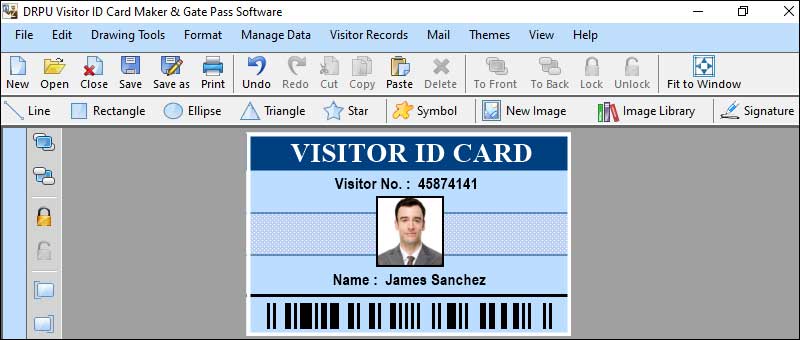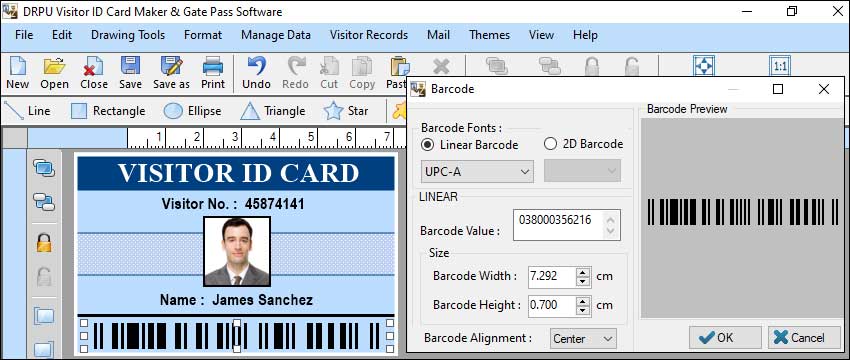Here are some of the common types of visitor ID cards that can be produced:

-
Temporary Visitor ID Cards:
These cards are typically issued for short-term visitors or guests who require access to a specific facility or event for a limited duration. They usually display the visitor's name, a photograph, the date of issuance, and an expiration date.
-
Employee Visitor ID Cards:
These cards are used by employees to identify themselves when visiting another facility or organization. They may display the employee's name, photograph, company name, and possibly their position or department.
-
Contractor ID Cards:
Contractor ID cards are designed for individuals or companies hired to perform specific tasks or services within a facility. These cards often include the contractor's name, company logo, photograph, and details of the work being performed. They may also specify access levels and validity periods.
-
Event Badges:
Event badges are created for attendees of conferences, seminars, trade shows, or other large-scale events. They typically include the participant's name, organization, event logo, and sometimes a barcode or QR code for tracking attendance or granting access to specific areas within the event.
-
Security Access Cards:
Some visitor ID card makers also offer the capability to produce access control cards that grant specific levels of entry or restricted access within a facility. These cards often incorporate advanced technologies such as magnetic stripes, RFID (Radio-Frequency Identification), or smart card chips to enable secure and convenient access.
-
Customized Cards:
Visitor ID card makers may provide options for customization, allowing clients to design cards that align with their branding or specific requirements. This can include incorporating company logos, color schemes, unique designs, or additional information fields based on the client's needs.
Security of Visitor ID Cards
Visitor ID cards can be an effective security measure when properly implemented, but their level of security depends on various factors. Let's explore the details:

-
Purpose:
Visitor ID cards are primarily used to identify and track individuals who are not regular employees or members of an organization. The purpose can range from enhancing security, managing access control, ensuring compliance, and facilitating visitor management processes.
-
Design and Features:
The security of visitor ID cards starts with their design and features. Common security elements include unique identification numbers, holograms, barcodes, QR codes, magnetic stripes, or RFID chips. These elements help authenticate the card's legitimacy and enable easy verification by security personnel.
-
Issuance Process:
The security of visitor ID cards also depends on the process of issuance. Organizations should have a well-defined procedure to verify the identity of visitors and validate the information provided. This may involve checking identification documents, capturing photographs, and collecting necessary personal details.
-
Access Control:
Visitor ID cards often come with access control features, such as time-limited validity, restricted access to certain areas, or access to specific events. These measures enhance security by ensuring that visitors are only granted access to authorized areas or activities during their visit.
-
Visitor Management Systems:
Visitor ID cards can be integrated with visitor management systems that help streamline the check-in and check-out process. These systems can store visitor information, record entry and exit times, and provide real-time monitoring. A robust visitor management system adds an extra layer of security and accountability.
-
Verification and Authentication:
Security personnel or authorized personnel should be trained to verify and authenticate visitor ID cards. This can be done by visually inspecting the card, scanning barcodes or QR codes, or using specialized card readers to read magnetic stripes or RFID chips. The verification process ensures that only valid cards are accepted.
-
Data Protection:
Visitor ID cards may contain personal information about the visitor, such as their name, photograph, company affiliation, and purpose of visit. Organizations must handle and protect this data in accordance with relevant privacy regulations. Adequate measures should be in place to prevent unauthorized access, loss, or misuse of visitor information.
-
Card Retrieval and Destruction:
After a visitor's departure, the ID card should be promptly retrieved and securely destroyed or deactivated to prevent unauthorized reuse. Neglecting this step could lead to potential security breaches or unauthorized access if the card falls into the wrong hands.
-
Continuous Evaluation and Improvement:
The security of visitor ID cards should be an ongoing process. Organizations should regularly assess their security measures, identify potential vulnerabilities, and implement necessary improvements to stay ahead of evolving threats.
While visitor ID cards can contribute to security, it is important to note that no system is completely foolproof. Determined individuals with malicious intent may still find ways to bypass or counterfeit ID cards. Therefore, it's crucial to employ additional security measures like video surveillance, trained security personnel, and robust access control systems to complement the use of visitor ID cards.